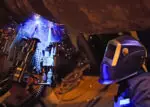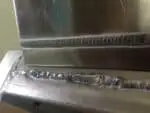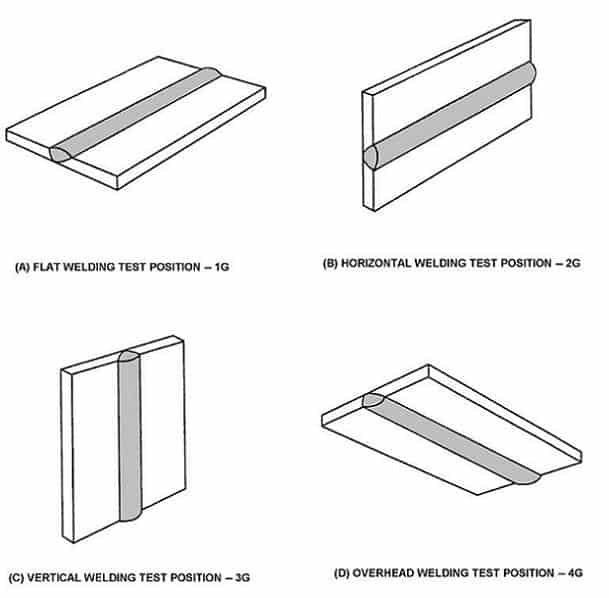
Four basic welding positions have been recognized by the American Welding Society:
-
-
- Flat
- Horizontal
- Vertical
- Overhead
-
While this may appear simple, welding is really a complicated art that requires experience and practice. It is often performed on structures where positions are predetermined such as a ceiling, a floor or a corner.
So, let’s take a look at some of the basics of welding positions. What exactly is a welding position? Does one really need more than one position and how should I choose the correct position?
The Why of Various Positions
If you are not a welder and have never had the occasion to fuse any type of metal, you may simply assume that a welder puts on his mask, turns on his torch, and melts and fuses the metals at hand. It might seem that he or she just picks up a piece of metal and positions it as he needs to join it to another.
In reality, joining metals is much more involved than appearances may imply. Depending on the job at hand, a welder will need to be able to weld in just about any position. You may have to attach pieces of metal to a corner, a ceiling, or even a floor.
Professional welding associations and welding educators indicate four primary welding positions.
What does Welding Position mean?
The term welding position really signifies a technique for welding. The specific position or technique is used by a welder to join metals. This may mean that they are welded directly in a position that they already hold, or they may be welded into a position that permits the piece to be used efficiently.
The welding position basically refers to the position or location a welder has in relation to the welding point. Clearly, gravity will have a role because it will influence in which direction the welding consumable or filler material will flow.
The Four Basic Primary Welding Positions
1.) Flat Position. This is the simplest and easiest of welding positions. You may hear it referred to as the “downhand ” position. This will also probably be the first position you will learn if you are new to welding. The metals that need to be joined are positioned flatly.
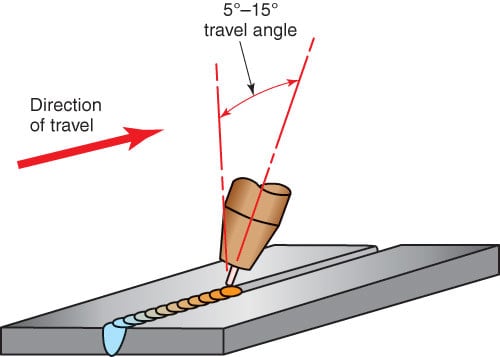
A welder will use the electric arc to pass over the pieces, moving back and forth in a direction that is horizontal. The upper or top side will be welded together in such a way that molten metal can fill any grooves.
2.) Horizontal Position. This is what is called the “out-of-position” weld and it requires a higher skill level to execute. The axis for welding is horizontal, hence its name. The actual execution of this type of position will depend on the kind of weld needed.
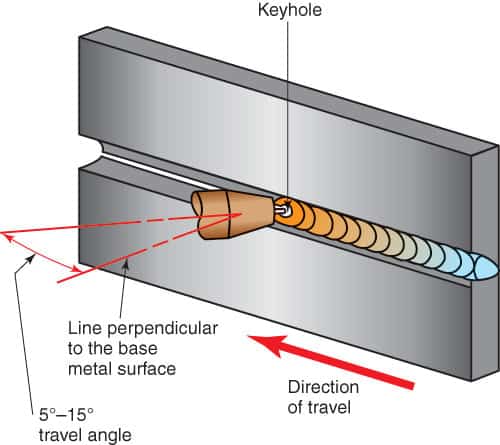
For example, when performing a fillet weld, the welder will place the weld bead on the point where a horizontal metal piece and a vertical metal piece form an angle of 90°. Another example is a groove weld. In this case, the weld will be executed along the vertical plane.
3.) Vertical Position. When performing a vertical position weld, the plate and the weld will be positioned vertically.
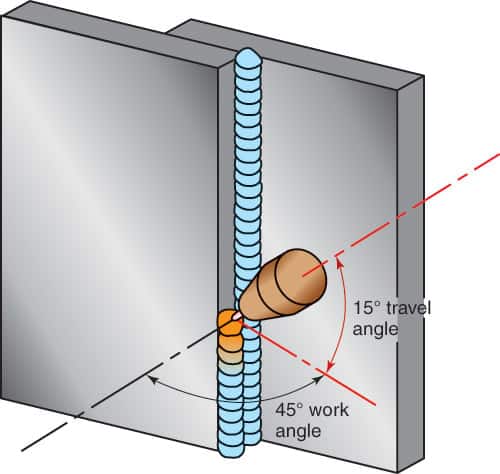
This is a difficult position to execute for beginners because, during the execution of the weld, the molten metal will flow downwards and tend to pool or pile up.
4.) Overhead Position. This is undoubtedly the most challenging position in welding. It is performed with both pieces of metal positioned above the welder.
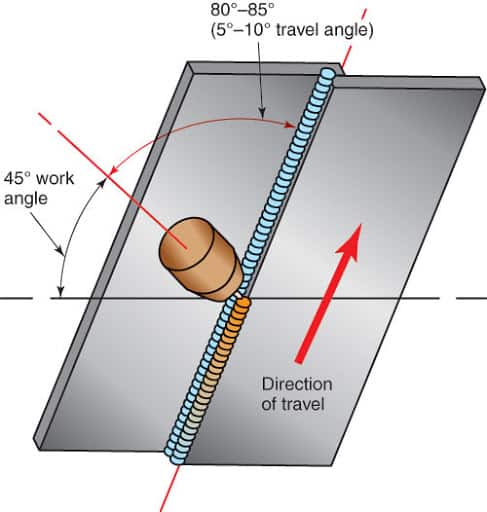
In this situation, the welder will need to position or angle himself or herself to perform the weld, positioning the equipment to reach the joints to be welded.
A major difficulty with this position may be metal sagging that will create a crown. To manage this situation, the molten metal pool should be kept as small as possible.
Two More Positions
A fifth position and a sixth position are named by the American Welding Society and the American Society of Mechanical Engineers.
1.) Pipe welding positions. These positions refer to pipe welding when the pipe’s axis is horizontal, stable and does not turn or rotate, or it can refer to a vertical position used to weld pipe butts.
2.) Overhead Weld Position or Welder Certification Test Position. This refers to an overhead pipe position where one pipe is positioned at a 45° angle to another pipe.
This is one of the most difficult and complex positions if not the most difficult. It requires welders to change many body positions to complete the weld.
Principal Types of Welds
The two principal kinds of welds used in the four primary positions are:
Fillet Weld. The fillet weld refers to the joining and fusing of two pieces of metal at a right angle to one another.
Grove Weld. A grove weld signifies a weld that forms when a filler metal is placed in a groove between two pieces of metal.
Basic Types of Weld Joints
When welds are combined with joints, they are called weld joints. The point or location where two pieces of metal are joined, or more than two pieces is what helps to distinguish weld joints. There are five basic kinds of weld joints:
-
-
- Butt. A butt joint signifies when two pieces of metal in the same plane join with their edges joining.
- Lap. The lap joint signifies a joint where two pieces of metal overlap each other partially.
- Corner. A corner joint indicates the fusion of two pieces of metal positioned t a 90° angle.
- T. The T weld indicates what its name implies. Two pieces of metal are fused at right angles and form the shape of a “T”
- Edge. An edge joint indicates that the flat sides of two pieces of metal are fused together.
-
Welding Symbols
If you have a blueprint to read for a welding project, it’s important to know common welding symbols and exactly what they indicate.
| Welding Position | Type of Weld | Welding Symbol |
| Flat Position | Fillet Weld | 1F |
| Flat position | Groove Weld | 1G |
| Horizontal Position | Fillet weld | 2F |
| Horizontal Position | Groove Weld | 2G |
| Vertical Position | Fillet weld | 3F |
| Vertical Position Uphill | Groove Weld | 3G |
| Vertical Position Downhill | Groove Weld | 3G |
| Overhead Position | Fillet weld | 4F |
| Overhead Position | Groove Weld | 4G |
| Pipe horizontal position | Groove Weld | 5G |
| Uphill Vertical position | 5G | |
| Downhill Vertical Position | 5G | |
| Uphill position | 6G | |
| Downhill Position | 6G |
FAQs
What are the most common terms used for various welding positions?
Normally a number will be used to indicate the position and a letter to indicate the weld type.1 refers to a flat position, 2 to a horizontal position, 3 to a vertical position, and 4 to an overhead position. 5 and 6 refer to pipe welding.
What is the difference between Fillet and Groove welds?
A Fillet weld refers to a closed weld. There is no cut through the base metal. The Fillet procedure requires a clean surface and a good fit. Fillet welds are divided into lap joints and T joints.
A Groove weld refers to the fact that a groove is created between the two pieces of metal that are to be welded together. This type of weld is subdivided into edge joints, corner joints or butt joints.
What is the difference between a single groove weld and a double groove weld?
A single groove weld indicates that the edge preparation of the metal plates is done from one side only. The single groove weld is generally used for pieces that have a thickness from 5 to 15 mm.
A double weld means that the edge preparation is done on both sides of the pieces to be welded. The double grove weld is used normally when the metal thickness is 25mm or more or when the distortion of a weld joint must be controlled.
The double groove prep will reduce the weld metal’s deposit volume by 50% when compared to a single groove weld.
A Final Thought
A welding position can literally make or break the outcome of a weld by determining weld quality. A welder’s position certification will indicate what type of welding he or she can perform professionally.
6G welding certification will mean that a welder can weld in all positions and is prepared for the most complicated of welding challenges and situations that can arise.
Expertise and skill on the job will guarantee the final success of any welding project. Regardless of the position you choose, always consider the location and safety when proceeding. We hope we have provided you with some helpful insight and thank you for reading.




